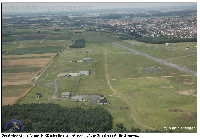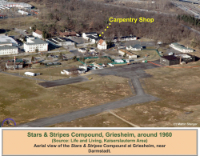|
Vaughan Family Timestream® Maps |
| Home Biography People Places Multimedia: Making It Work On the Water Writings/Presentations |
Darmstadt/Griesheim 1965-1966
Jobless and Broke
Driving south on my Ariel motorcycle in October, it got colder and colder. I was headed for Spain or points warmer, having given up the job at the Biersdorf factory. By Kassel I was down to my last ten dollars and not sure how far that would last. That's where I picked up an American hitch-hiker at the Jugendherberger in Kassel who was headed to Frankfurt to visit a friend in the military. I ended up following him to the I. G. Farben Building, and walking down a long industrial-green hallway with little signs hanging on chains above the many doors. At one door was a bulletin board; it exclaimed JOB OPENINGS! The door said "Personnel." I walked in. Two hours later, I was employed as a cabinet maker at a place called Stars and Stripes in Darmstadt and had $100 in my pocket from a Red Cross loan. Show up on Monday morning and go to work! It was a good time to be an American vagabond in Germany!
Stars and Stripes Newspaper
"The European edition of The Stars and Stripes which rolls off the presses every day at Darmstadt, Germany, was born in battle in the musty offices of a London printing plant.
The date was April 18, 1942, and the paper, which also was printed during World War I and discontinued at the finish, again was "drafted" to give American servicemen overseas all the news from home -- sports, comics and items of national and international interest.
As the American Army in Europe grew and forged across "Festung Europa", the paper grew with it. By the time the war ground to a halt, The Stars and Stripes was printed in 25 different areas, sometimes in a truck containing a small press and often under fire.
Its reporters flew with the Army Air Force on bombing missions, followed the infantry into battle, made a landing with the Rangers and jumped with the paratroopers on D-Day to give its readers on-the-spot coverage.
Today The Stars and Stripes has a circulation of about 145,000 and is read by US military and civilian personnel from Norway to Saudi Arabia, an area embracing 19 countries.
The paper is printed in a modern plant at Darmstadt, Germany. The printing plant, editorial and central administrative offices are in buildings which before and during World War II were occupied by a German Luftwaffe training school. Adjoining The Stars and Stripes facilities is an airstrip now used by light planes and helicopters of the US Army.
Apart from its own reporters and news bureaus, the paper utilizes the news gathering facilities of the Assoiated Press, United Press International and other Stateside and European news agencies.
Today's Stars and Stripes contains approximately 25,000 to 30,000 words, the equivalent of a 74-page Stateside tabloid newspaper. Stripes is a 24-page daily tabloid newspaper, carries no advertising, and is printed in four editions.
To keep its readers as fully informed as possible, The Stars and Stripes operates more than 400 newsstands within the 19 countries it serves by truck, rail and air. The newsstands carry more than 1,000 US periodicals, pocket books and hardcover books.
The present edition of the paper employes 2,000 non-American personnel, 168 American and Allied civilians and has about 20 military personnel assigned. The newspaper is under the supervision of Colonel Ridgway P. Smith, Jr., Editor-in-Chief."
(Source: Life and Living, Kaiserslautern Area, 1961 or 1962)




